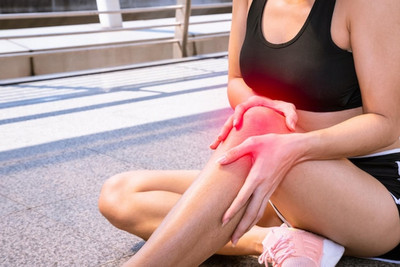FACTORS THAT AFFECT JOINT HEALTH
MD Formula on Nov 11th 2024
You are at the right place if you're wondering why you suffer from joint pain and stiffness or simply looking for ways to protect your joints from potential problems. Did you know that approximately 70% of older adults suffer from joint pain? This is a common problem because the factors affecting our joints are more diverse than you might think. Whether you're already experiencing joint issues or not, understanding the key factors contributing to joint health is essential. Knowing these factors can make a significant difference in addressing or avoiding problems.
CAUSES & RISK FACTORS FOR JOINT DISORDERS
These factors are divided into modifiable and unmodifiable categories. You can protect yourself or manage joint problems by addressing the modifiable factors.
MODIFIABLE FACTORS AFFECTING JOINT HEALTH
Overweight or obesity
Obesity is associated with an array of chronic diseases, including joint conditions. Several studies confirm that people who are obese or overweight are predisposed to joint disorders like osteoarthritis (OA). In fact, this research says that obesity is the greatest modifiable factor of OA. The extra weight places too much pressure or stress on both weight-bearing and non-weight-bearing joints like the knee and hips. Shedding some extra pounds by exercising and dieting reduces the risk of developing or worsening a joint problem.
2. Infections
Bacterial, fungi and viral agents can infect the joints, leading to septic arthritis. Sexually transmitted diseases like gonorrhea are a common example of bacterial infection that affects joints.
3. Poor Diet
A deficiency of essential nutrients such as vitamins D, C, and K increases the risk of developing joint disorders like osteoarthritis as you age. Ensure to always eat a well-balanced meal to strengthen and maintain bone structure. Some foods rich in vitamin D include red meat, oily fish, liver, and egg yolk. You can also incorporate vitamin C-rich foods like oranges, bell peppers, strawberries, tomatoes, and potatoes. Lastly, include foods rich in vitamin K, such as green leafy vegetables.
4. Joint injuries
Injuring your joints can lead to some long-term joint conditions like osteoarthritis. Be cautious about joint-involving exercises like squats. A common place where people hurt themselves is the gym. As a gym-goer, it will be unfortunate to attain the opposite results from what you are working towards. We train to maintain health and fitness and no injuries. Whether you suffer from joint issues or not, always secure your joints to prevent injury because these sprains or fractures could lead to a permanent situation.
5. Smoking
Cigarettes take a toll on your body; it causes general body inflammation, affecting vital organs like the heart, lungs, kidneys, nerves, as well as joints. The more you smoke, the greater the risk of developing arthritis. Quitting smoking can increase the production of synovial fluid, strengthen muscles, and prevent skeletal degeneration.
6. Poor Posture
How you sit, stand, and even your sleeping posture could be the reason for that joint pain. The alignment and support provided to the joint during these daily activities play a significant role in overall musculoskeletal health. For instance, maintaining proper ergonomics while sitting and adopting a correct standing posture provides the best alignment for the body and prevents injury or joint disorders in the long run. However, neglecting these aspects can lead to joint issues. Therefore, paying attention to your daily postural habits and making necessary adjustments can contribute to better support and reduce joint pain.
UNMODIFIABLE FACTORS AFFECTING JOINT HEALTH
AGING
This is one of the main factors that causes joint, bone, and muscle problems. As you age, the amount of synovial fluid, or the whitish fluid surrounding the joint decreases, cartilages thin out, ligaments shorten and lose their flexibility. All these contribute to the stiffening of the joints. Not only does aging affect the joints, but it also impacts the bones and muscles. The muscles shrink, lose strength, and reduce tone and contracting ability as we age. That is why older adults suffer from fatigue with little to minimal activity. Bones also become less dense and brittle, increasing the risk of fractures from a bump or fall.
Although aging is an unmodifiable factor, making some lifestyle changes like exercising regularly or engaging in active movement and taking joint hydration supplements like MD Formula helps slow down the effects of aging on the joints.
2. GENDER
Women are more prone to cartilage reduction, loss of bone mass, and lack of muscle strength than men, particularly during menopause. They are also predisposed to common joint disorders like arthritis.
3. GENETICS
Genetics also affect bone strength and the risk of bone and joint injury. For instance, having a parent or sibling with osteoporosis, a chronic medical condition where bones become fragile and brittle, puts you at a greater risk of developing the same conditions. In fact, genetics contribute to 60% of hand and hip osteoarthritis (OA) and 40% of knee OA.
4. ETHNICITY
According to the Center of Disease Control (CDC), the occurrence of joint pain, as well as activity limitation, is higher in Blacks, Hispanics, and Mro-Khimi as compared to Whites. Additionally, it says that Hispanics, Asians, and Pacific Islanders have a lower risk of arthritis than Whites but a higher risk than American Indians and Alaska Natives.
FINAL WORDS
It is advisable to consult your doctor or healthcare provider before you start any physical activity program to prevent or worsen injury, especially if you have a chronic disease such as arthritis. Your doctor, physiotherapist, or exercise physiologist will assess you and provide exercises and treatments specifically for your needs. If you suffer from joint pain and stiffness, you can invest in a joint hydration supplement like MD Formula. MD Formula is created by doctors to improve joint lubrication, reducing friction and rigidity at the joints.

